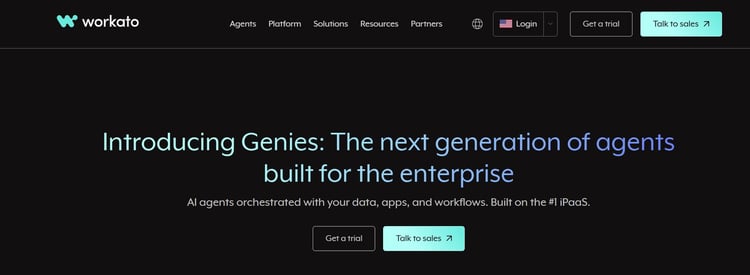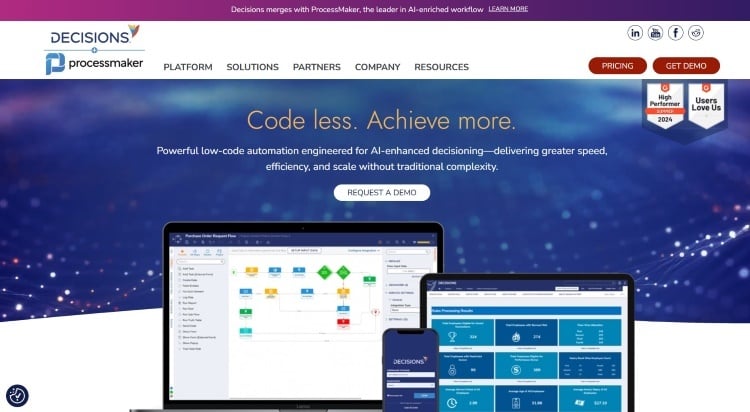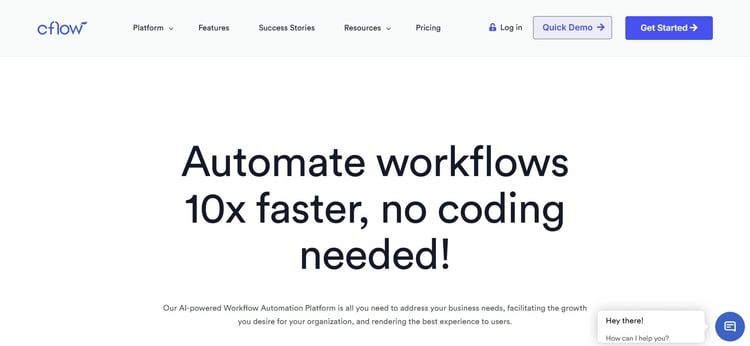Next Matter is an operations automation platform designed to help teams coordinate recurring workflows. It offers workflow orchestration, task assignment, and integrations to manage day-to-day operations.
However, many growing organizations find it limited in scalability, AI functionality, depth of workflow automation, and pricing transparency.
As automation becomes central to digital transformation, businesses are exploring workflow automation tools beyond Next Matter, seeking options that combine ease of use with enterprise-grade governance, AI capabilities, and transparent pricing.
This guide,
- Reviews the top 10 Next Matter alternatives for 2026
- Compares key features, strengths, and pricing
- Outlines best-fit use cases for each tool
- Shows why FlowForma is the most complete, transparent choice for scaling automation
Key Takeaways
- Next Matter helps manage workflows but falls short in flexibility, compliance, and depth of automation for complex business processes.
- Businesses are switching to platforms that offer better scalability, AI-powered process creation, and data governance aligned with modern automation needs.
- The top contenders include FlowForma, Kissflow, and Pipefy, and others like Nintex, Workato, and Smartsheet that serve niche needs across teams, departments, and enterprises.
- FlowForma combines no-code simplicity, built-in AI, Microsoft 365 integration, and transparent pricing in one platform that is easy for managers and non-technical users to adopt.
- Its all-in-one design helps organizations accelerate automation without hidden costs or dependence on IT, making it an easy choice for customers evaluating Next Matter competitors.
The best Next Matter alternatives combine AI automation, smooth integrations, and audit-ready governance. FlowForma, Kissflow, and Pipefy lead the list for their balance of usability and scalability.
In contrast, others like Nintex, Workato, and Cflow offer specialized capabilities for different operations, teams, and small businesses.
|
Platform |
Best For |
AI & Workflow Automation |
Compliance & Governance |
Pricing Plans |
|
FlowForma |
Enterprise-grade AI-powered automation |
Advanced (AI Copilot, AI Agent, Summarization, Smart Assistants, and AI-Powered Vendor Risk Assessment) |
Built-in compliance and audit module |
Transparent process-based pricing |
|
Process Street |
Recurring checklist-based workflows |
Moderate |
Limited |
Tiered pricing |
|
Low-code enterprise workflows |
Moderate |
Good |
Custom quote |
|
|
Pipefy |
Operations and HR workflows |
Basic automation |
Limited |
Freemium + tiers |
|
Nintex |
Large enterprise automation |
Strong |
Strong |
Quote-based |
|
Workato |
System integration workflows |
Excellent |
Moderate |
Per-connector pricing |
|
Decisions |
Rule-driven business logic |
Strong |
Strong |
Quote-based |
|
Smartsheet |
Project workflow visibility |
Limited |
Moderate |
Tiered pricing |
|
Microsoft Power Automate |
Microsoft ecosystem users |
Strong |
Moderate |
Per-flow pricing |
|
Cflow |
SMB automation |
Moderate |
Limited |
Affordable tiered pricing |
Comparison of 2026 workflow automation platforms: key positioning, feature strengths and pricing models for alternatives to Next Matter
Top Next Matter Alternatives in 2026
Now, let us look at the top Next Matter competitors in detail:
1. FlowForma
 Caption: FlowForma homepage
Caption: FlowForma homepage
FlowForma is an AI-powered business process automation tool designed for citizen developers who want to automate complex workflows while still giving IT oversight for comprehensive governance. It combines forms, workflows, document generation, analytics, and AI into a single, integrated tool with Microsoft 365.
FlowForma is ideal for compliance-focused and heavily regulated industries, including construction, healthcare, and financial services, that need secure, fast, and transparent automation software that supports end-to-end business processes.
FlowForma’s Key Features
Let us take a detailed look at FlowForma’s key features:
1. No-code automation

FlowForma is a no-code platform with an easy-to-use interface
FlowForma enables citizen developers to create end-to-end workflows with minimal IT involvement while ensuring compliance with regulations such as HIPAA, ISO, and GDPR. IT still retains oversight for governance, but business users can take the lead in workflow automation.
2. AI-powered automation
 FlowForma’s AI Page
FlowForma’s AI Page
FlowForma’s AI suite redefines how teams build and manage workflows:
- AI Copilot: Converts plain text instructions or uploaded process diagrams into fully structured workflows in seconds, cutting setup time drastically.
Video showcasing the AI Playground
- Agentic AI: Performs context-aware actions within processes, such as reading invoices, validating data, and automatically updating linked systems. It provides context-aware, intelligent recommendations within workflows.
Watch FlowForma’s AI Masterclass to learn all about building workflows using AI agents
- Smart Assistants: Supports both builders and end users, offering step-by-step guidance, configuration help, and contextual prompts.
- Summarization: AI provides a concise snapshot of any ongoing process, showing key decisions, blockers, and pending actions for faster approvals.
- Discovery Agent: Analyzes existing documentation across departments to identify and suggest new automation opportunities, helping organizations continuously drive improvement and productivity.
Caption: FlowForma’s Discovery Agent
- AI Insights & Analytics: AI monitors process performance, highlights inefficiencies, and suggests improvements.
3. FlowAssure – AI for Vendor Risk Management
FlowAssure is FlowForma’s newest AI-powered product, built to simplify vendor risk and compliance management. It automates vendor assessments, cybersecurity questionnaires, and reviews of Pen Tests, ISO, and SOC 2 Type II certifications—all within a secure, Microsoft 365–based environment.
Using AI agents, FlowAssure analyzes responses, flags potential compliance gaps, and helps organizations approve vendors with confidence. It’s particularly valuable for regulated sectors like healthcare, finance, and construction, where security, transparency, and auditability are non-negotiable.
Introducing FlowAssure by FlowForma
4. Document and form automation
FlowForma allows teams to design dynamic digital forms that capture structured data accurately at every step. These forms automatically feed into document templates, enabling instant generation of reports, letters, contracts, or approval records.
The result is consistent, audit-ready documentation without manual effort or errors, which directly supports customer success and governance.
 FlowForm automates document generation at scale
FlowForm automates document generation at scale
5. Seamless integrations
FlowForma connects effortlessly with Microsoft 365 (including SharePoint, Teams, and Outlook) thousands of third-party apps and systems through APIs and connectors.

Caption: FlowForma integrations
This integration ensures that process data flows smoothly between departments, creating a single source of truth without the need for complex middleware, and helping organizations avoid data breaks between apps.
6. In-built compliance and data security
All data processed through FlowForma remains securely stored within each client’s SharePoint tenancy. Every workflow automatically logs actions, timestamps, and version histories for complete auditability.
 Features of FlowForma’s compliance module
Features of FlowForma’s compliance module
The built-in compliance module aligns with frameworks such as GDPR, ISO 27001, and HIPAA, supporting organizations in regulated industries and providing robust security and control.
FlowForma Pros
- 10x faster process automation than low-code tools
- Transparent, process-based pricing with unlimited workflows
- In-built compliance and audit support, which is critical for security and control
- Simple adoption with quick ROI and strong vendor support, ensuring customer success
- AI-powered workflow automation and analytics for enhanced workflow and decision-making
FlowForma Cons
- Requires a SharePoint environment to operate
FlowForma Pricing
FlowForma offers a process-based pricing model with unlimited workflows under one licence.
There are no hidden costs or complex pricing tiers, giving organizations full clarity and scalability as their automation needs expand. It’s also easier to see real value compared with other Next Matter competitors or “free” tools that later add surprise charges.
Customer Success Stories for FlowForma
Companies across insurance, healthcare, education, construction, and financial sectors have adopted FlowForma to simplify complex workflows and accelerate digital transformation.
Customers consistently praise the platform for its ease of use, no-code capabilities, and complete workflow automation.

Customer testimonial for FlowForma by Aon

G2 Customer testimonial for FlowForma

G2 Customer testimonial for FlowForma
Business users highlight how easily customizable the platform is and how quickly they can roll out new processes and maintain full visibility, governance, and compliance through FlowForma’s built-in controls.
%20(1)-1.png?width=600&height=400&name=Wills%20Quote%20(600%20x%20400%20px)%20(1)-1.png)
Customer testimonial for FlowForma, Morley College London
Case study in focus: How Aon transformed its operations with FlowForma
Aon, a leading global insurance organization, replaced legacy processes with automated workflows that saved significant time and money.
Before FlowForma, different business units managed information through disconnected Excel sheets and paper-based systems, methods increasingly misaligned with the company’s IT-led digital transformation strategy.
Aon aimed to build a single data repository—a centralized platform supporting automated, transparent, and auditable workflows that reinforced compliance, a critical focus for any insurer. Already using SharePoint, the company sought a more integrated solution for process automation within Microsoft 365.
After implementing FlowForma, the company achieved faster approvals, improved consistency, and stronger governance across departments—saving time, reducing manual effort, and aligning with its digital transformation strategy.
2. Process Street

Process Street Homepage
Process Street simplifies recurring workflows such as employee and client onboarding and approvals. It’s designed for non-technical teams that need process documentation and structure without complex automation logic, and it works well for small businesses that want to track and manage tasks.
Process Street Key Features
- Conditional logic for dynamic workflows
- Approval tasks for multi-step reviews
- Integrations with Slack, Zapier, and Salesforce
- Form fields for structured data entry
- Template library for fast deployment
- Automation triggers for repetitive actions that keep work moving without waiting
Process Street Pros
- Easy to use and intuitive for teams
- Suitable for documenting and managing SOPs
- Strong collaboration tools for checklists and recurring processes
Process Street Cons
- Limited reporting and analytics
- Not built for complex or multi-department workflows in larger enterprises
3. Kissflow
 Kissflow homepage
Kissflow homepage
Kissflow offers a balance of low-code flexibility and enterprise-grade process management. It’s best for organizations seeking customizable workflows, analytics, and scalability in a single platform.
Kissflow Key Features
- Unified workspace for projects, workflows, and cases
- Custom form builder for advanced data capture
- Real-time analytics dashboards
- Role-based access and permissions for control and governance
- Integration hub with major CRMs and ERPs
- Process templates for common business functions
Kissflow Pros
- Highly configurable for enterprise needs
- Strong analytics and visual reporting
- Scalable for cross-functional automation
Kissflow Cons
- Steeper learning curve than no-code tools
- Pricing details not publicly listed, making it harder to compare pricing plans early in evaluation
4. Pipefy

Pipefy homepage
Pipefy enables teams to manage processes through visual boards, making it ideal for HR, finance, and procurement workflows. Its drag-and-drop interface simplifies process setup, while templates make onboarding fast and help teams create workflows quickly.
Pipefy Key Features
- Custom form builder for data intake
- Automation rules for triggers and approvals
- Integration with Slack and Google Workspace
- Reporting dashboards for performance insights
- Conditional logic to personalize workflows
Pipefy Pros
- Highly visual and user-friendly
- Quick to deploy for department-level workflows
- Large template library that helps managers and employees standardize tasks
Pipefy Cons
- Limited AI or predictive automation
- Restricted compliance and governance options for regulated organizations
5. Nintex

Nintex platform
Nintex is known for automating enterprise workflows with RPA and process mapping capabilities. It’s best suited for large organizations that can invest in professional setup and integration, and that need a workflow automation tool that connects deeply with legacy systems.
Nintex Key Features
- Process mapping and visualization
- Robotic process automation for repetitive tasks
- Document generation and e-signature support
- Advanced analytics and reporting
- Integration with Microsoft, SAP, and Salesforce
Nintex Pros
- Enterprise-ready with extensive functionality
- Deep integration with existing systems
- Comprehensive analytics and tracking to report on performance
Nintex Cons
- High implementation and licensing costs.
- Complex setup requiring IT support and specialist knowledge base skills.
6. Workato

Workato homepage
Workato focuses on connecting applications and automating data flows between them. It’s ideal for IT and operations teams managing multiple business systems and looking to save time on manual integrations.
Workato Key Features
- Prebuilt “recipes” for common integrations
- Real-time data synchronization
- Customizable automation logic
- Bot framework for repetitive workflows
- Enterprise-grade security and access control
Workato Pros
- Best-in-class integration capability
- Suitable for enterprise data orchestration
- Wide ecosystem of connectors that bridge a large range of apps
- Centralized error tracking and management
Workato Cons
- Expensive per-connector pricing.
- Requires technical expertise for configuration and ongoing account management.
7. Decisions

Decisions homepage
Decisions specializes in automating rule-based workflows. It allows business users to build complex decision logic without coding, making it popular in finance, compliance, and insurance.
Decisions Key Features
- Visual rule engine for logic-based workflows
- Drag-and-drop process designer
- Integration with APIs and databases
- Real-time analytics and dashboards
- Dynamic form builder
Decisions Pros
- Customizable and flexible
- Support for audit and governance
- Security management with permissions control
Decisions Cons
- Higher learning curve for new users
- Limited AI assistance for users who want more guidance
8. Smartsheet
 Smartsheet homepage
Smartsheet homepage
Smartsheet combines project management and automation in a spreadsheet-like interface. It’s intuitive for teams used to Excel and ideal for tracking project timelines and workflows, especially for managers who like a grid-style desk view of work.
Smartsheet Key Features
- Grid, card, and Gantt views
- Automation rules for reminders and updates
- Form-based data collection
- Integrations with Microsoft 365 and Jira
Smartsheet Pros
- Familiar interface for Excel users
- Provides real-time dashboards and KPIs
- Offers project visibility and tracking
Smartsheet Cons
- Limited workflow intelligence
- Basic compliance and governance controls, not ideal for heavily regulated service environments
9. Microsoft Power Automate

Power Automate homepage
Power Automate offers strong automation across Microsoft apps and external connectors. It’s ideal for organizations already in the Microsoft ecosystem who want to automate repetitive tasks and approvals.
Microsoft Power Automate Key Features
- Flow designer for task automation
- AI Builder for document recognition and predictions
- RPA for desktop automation
- Integration with 1,000+ apps
- Template library for common processes
Microsoft Power Automate Pros
- Integration within Microsoft 365
- Wide connector ecosystem
- Scalable for large enterprises
Microsoft Power Automate Cons
- Complex setup for advanced workflows
- Limited built-in audit and compliance tracking, often needing extra tools or custom development
10. Cflow

Cflow alternatives
Cflow is a lightweight workflow automation tool for small to mid-sized businesses. It’s simple, affordable, and effective for basic approvals and routine workflows, making it one of the more accessible Next Matter alternatives for small businesses.
Cflow Key Features
- Prebuilt templates for quick deployment
- Custom form creation and notifications
- Reporting dashboards for performance tracking
- Integration with Slack and Gmail
- Access control and permissions
Cflow Pros
- Simple to set up and use
- Cost-effective for small teams
- Cloud-hosted for easy access from any country or remote team
Cflow Cons
- Limited AI or analytics capabilities.
- Not suited for enterprise governance needs or complex customer success use cases.
Why FlowForma is the Best Next Matter Alternative
FlowForma is a comprehensive Digital Process Automation platform that unites intelligent workflows, AI automation, and built-in compliance within a single no-code tool.
While Next Matter focuses on coordination, FlowForma delivers end-to-end workflow automation with strong governance, seamless Microsoft 365 integration, and transparent process-based pricing. It functions as a complete workflow automation solution rather than just a coordination platform.
Here’s a quick side-by-side comparison of FlowForma vs Next Matter:
|
Feature |
FlowForma |
Next Matter |
|
Workflow Design |
Fully no-code, natural-language builder |
Basic visual workflow setup |
|
Ease of Use |
User-friendly with a drag-and-drop interface |
Steep learning curve for complex setups |
|
AI Capabilities |
Copilot, Agentic AI, Smart Assistants, Summarization, Discovery Agent |
Limited automation intelligence |
|
Document and Form Automation |
Built-in with templates and ISO-compliant document generation |
Limited documentation capabilities |
|
Microsoft 365 Integration |
Native and seamless |
Partial |
|
Governance, Compliance & Security |
In-built compliance module and audit trails, with data stored in the client tenancy |
Basic compliance tracking |
|
Pricing Model |
Transparent, process-based with unlimited workflows |
Custom quotes |
|
Deployment Speed |
Live within weeks |
Moderate |
|
Scalability |
Enterprise-ready across departments |
Moderate |
Side-by-Side Comparison of FlowForma and Next Matter across key workflow automation features
Start Your Automation Journey with FlowForma
 Caption: FlowForma customer testimonial
Caption: FlowForma customer testimonial
Next Matter is a capable operations tool, but it lacks the depth needed for enterprise-grade automation and long-term customer success.
Organizations seeking scalability, AI intelligence, and data control need a platform that delivers all three seamlessly without sacrificing security or governance.
FlowForma provides this balance—offering no-code simplicity, in-built compliance, and transparent pricing within a Microsoft 365 environment, making it the ideal choice for organizations that want an end-to-end workflow automation tool.
Its latest addition, FlowAssure, further strengthens this ecosystem by automating vendor risk assessments and compliance reviews with AI-driven precision, helping teams maintain security and trust across their extended network.
For teams ready to accelerate digital transformation with secure, intelligent workflows and stronger control over their accounts, tasks, and approvals, FlowForma remains the most complete and competent alternative to Next Matter in 2026.
Book a demo to see how quickly your business can go from manual to fully automated.
FAQs
1. What is Next Matter used for?
Next Matter helps coordinate operational workflows, task assignments, and process visibility for business teams, particularly in back-office operations and internal service processes.
2. Why are organizations switching from Next Matter to FlowForma?
FlowForma offers deeper AI functionality, document automation, built-in compliance, and full control of data within the client’s Microsoft 365 tenancy, delivering better value and more flexibility than many other Next Matter alternatives.
3. How does FlowForma handle compliance and data security?
All data stays within the client’s Microsoft 365 environment. Every process has audit trails, version control, and compliance support aligned with GDPR and ISO 27001, which is backed by strong security controls and governance.
4. What industries use FlowForma?
Financial services, insurance, healthcare, education and energy rely on FlowForma to securely digitize processes at scale, using it as their central automation platform to manage, track, and automate key workflows across multiple countries and languages.
.png) By
By 



